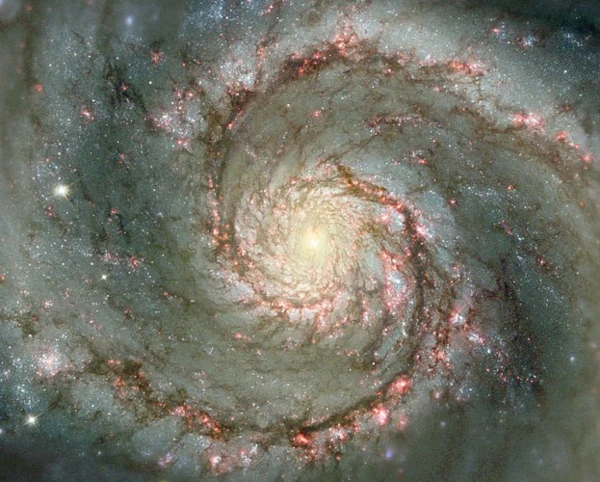
Galaxies are immense collections of stars, gas, dust, and dark matter, bound together by gravity. A typical galaxy contains between 10⁷ and 10¹² stars. Our Milky Way has about 200 billion stars and spans nearly 100,000 light-years.
A galaxy is not a homogeneous system. It consists of several dynamic components:
N.B.:
Dark matter has never been directly observed. Its presence is inferred from its gravitational effects on the dynamics of galaxies and clusters. Hypothetical particles such as WIMPs could be its constituents.
The classification of galaxies, proposed in 1926 by Edwin Hubble (1889-1953), is based on their observed morphology:
| Type | Main Characteristics | Star Formation | Comment |
|---|---|---|---|
| Elliptical (E) | Spheroidal structure, little gas and dust | Low or none | Probable result of ancient mergers |
| Spiral (S) | Flattened disk with spiral arms and central bulge | Active in the arms | Our Milky Way belongs to this category |
| Irregular (Irr) | Chaotic, disordered shape | Variable | Often resulting from gravitational interactions |
Source: NASA/IPAC Extragalactic Database and ESA Hubble Science - Galaxies.
Stars are not randomly distributed in the universe. They cluster into vast systems called galaxies, true stellar communities bound by gravity. This organization is not random but results directly from the fundamental physical laws governing the cosmic structure.
From the earliest moments of the universe, small density fluctuations in the primordial gas created slightly more massive regions than their surroundings. These overdensities began to attract surrounding matter through gravity. Since this interaction is always attractive, it amplifies groupings over time: the densest regions become even denser. This is how dark matter halos first form, followed by gas clouds that collapse to give birth to stars.
Newly formed stars remain trapped in this collective gravitational well. Their orbital speeds, several hundred km/s, are not sufficient to eject them from the system: they continue to orbit together around the galaxy's center, like bees around a cosmic hive.
Each star is attracted to all others, but the overall rotational motion prevents complete collapse. This balance between gravitational attraction and kinetic energy is analogous to that of a planetary system: the planets of the Solar System remain bound to the Sun by the same logic, on a smaller scale.
The average orbital speed \(v(r)\) of a star depends on the mass \(M(r)\) contained within its orbit according to the Newtonian relation \(v(r) = \sqrt{GM(r)/r}\). In a galaxy, the total mass includes not only visible stars but also invisible dark matter, which explains why observed speeds remain high even in peripheral regions.
Living in a galactic community promotes the formation, evolution, and death of stars. Interstellar gas clouds are continually enriched by supernovae that release heavy elements into the medium. These recycled materials then serve to form new generations of stars and planets.
Thus, galaxies function as cosmic ecosystems where matter circulates, transforms, and renews continuously. An isolated star, without external matter input, could not contribute to this galactic cycle.
Galaxies themselves are not isolated: they live in clusters or groups of galaxies, subject to the same dynamics of gravitational attraction. When they pass near each other, their gravitational fields mutually disturb each other, causing bursts of star formation called starbursts.
These interactions promote the growth of galaxies over cosmic time. In a few billion years, for example, the Milky Way and Andromeda are expected to merge to form a new giant elliptical galaxy sometimes called "Milkomeda."
The stability of a galaxy relies on the overall balance between gravity and the orbital motions of its stars. Each star, though independent, contributes to the cohesion of the whole, much like particles in a dynamically balanced fluid. Without this natural cooperation, no galaxy could have survived for billions of years in an expanding universe.
N.B.:
Galaxies are not just clusters of stars: they also contain gas, dust, magnetic fields, and especially dark matter. This invisible component represents about 85% of the total mass and ensures the cohesion of these stellar communities on cosmic scales.